Corporate Governance in Australia: Analysis of Reforms and Failures
VerifiedAdded on 2023/02/01
|13
|2982
|51
Report
AI Summary
This report provides a comprehensive analysis of corporate governance in Australia, specifically examining the attributes of good corporate governance, the role of poor corporate governance in the collapses of companies like HIH Insurance in the early 2000s, and the subsequent reforms introduced by the Australian government. The report explores key aspects of corporate governance, including the responsibilities of the board of directors, ethical conduct, and financial reporting. It highlights the failures of corporate governance that led to the downfall of several Australian companies and details the legislative and regulatory changes implemented in response, such as the Corporate Law Economic Reform Program Act (CLERP 9) and changes to auditor independence and accounting standards. The analysis includes specific examples from companies like HIH Insurance, One Tel, and Harris Scarfe, illustrating the impact of poor governance practices. The report concludes by emphasizing the importance of sound corporate governance for protecting stakeholders and ensuring the stability of the financial system.

Running head: CORPORATE ACCOUNTING
Corporate Accounting
Name of the Student:
Name of the University:
Author’s Note:
Course ID:
Corporate Accounting
Name of the Student:
Name of the University:
Author’s Note:
Course ID:
Paraphrase This Document
Need a fresh take? Get an instant paraphrase of this document with our AI Paraphraser
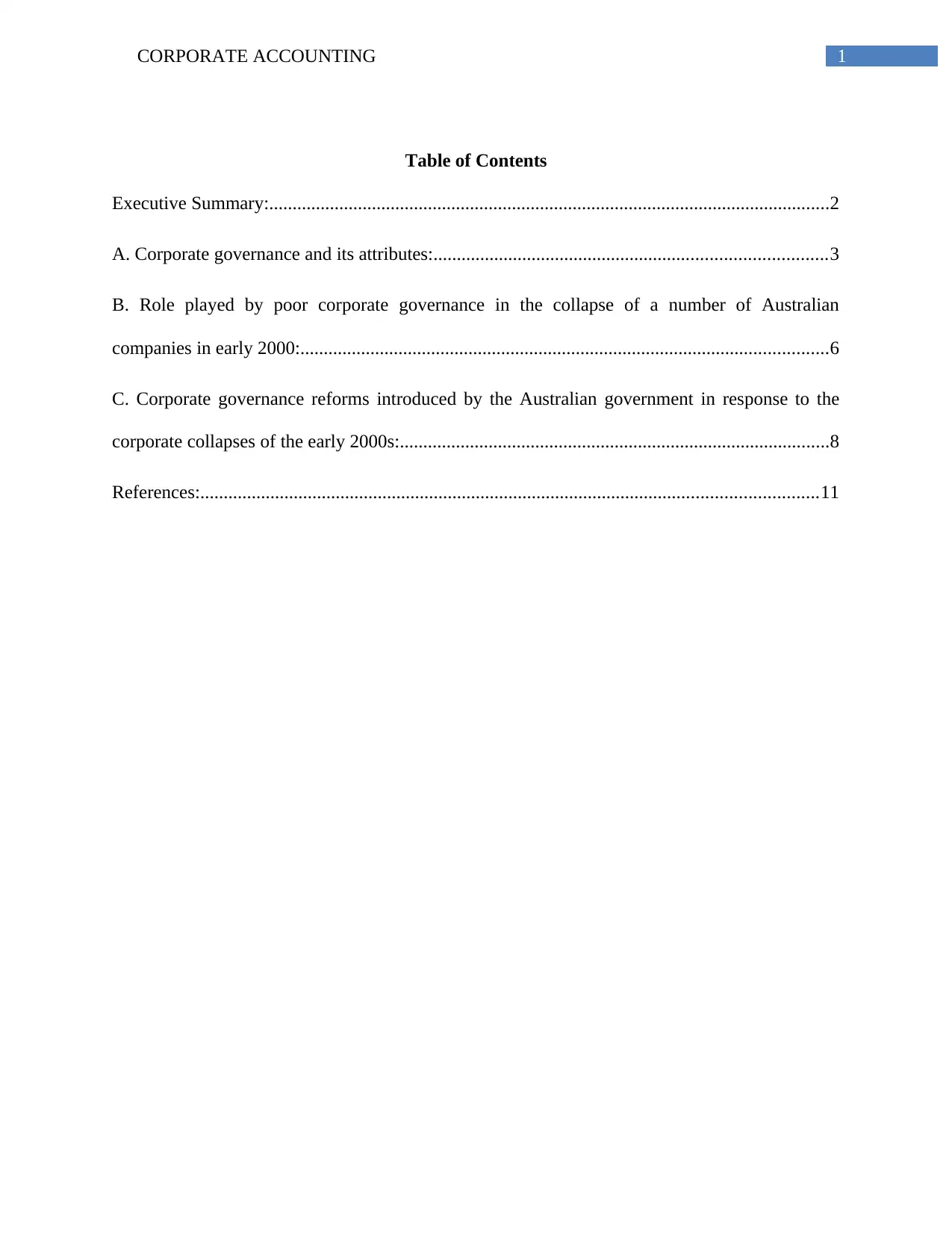
1CORPORATE ACCOUNTING
Table of Contents
Executive Summary:........................................................................................................................2
A. Corporate governance and its attributes:....................................................................................3
B. Role played by poor corporate governance in the collapse of a number of Australian
companies in early 2000:.................................................................................................................6
C. Corporate governance reforms introduced by the Australian government in response to the
corporate collapses of the early 2000s:............................................................................................8
References:....................................................................................................................................11
Table of Contents
Executive Summary:........................................................................................................................2
A. Corporate governance and its attributes:....................................................................................3
B. Role played by poor corporate governance in the collapse of a number of Australian
companies in early 2000:.................................................................................................................6
C. Corporate governance reforms introduced by the Australian government in response to the
corporate collapses of the early 2000s:............................................................................................8
References:....................................................................................................................................11
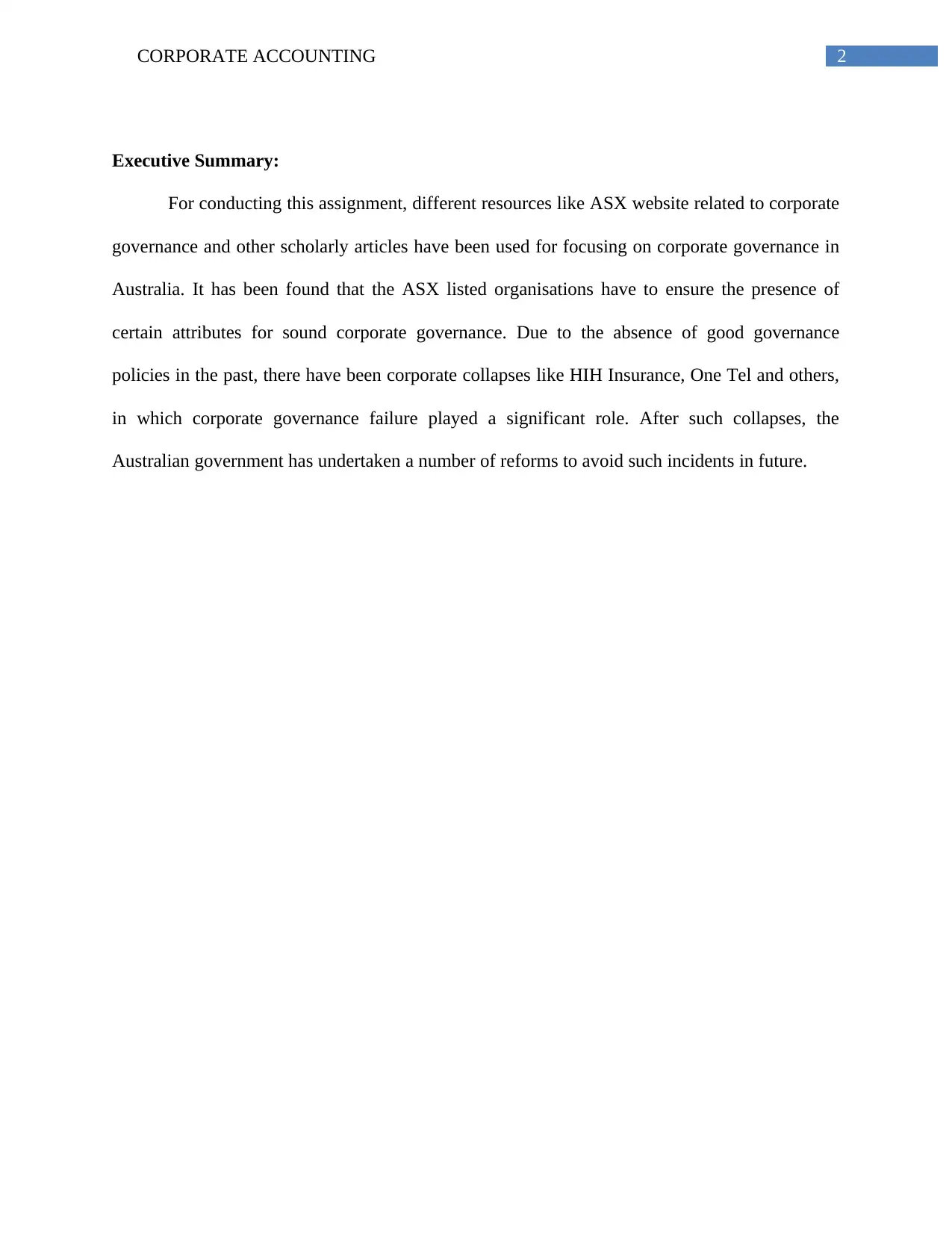
2CORPORATE ACCOUNTING
Executive Summary:
For conducting this assignment, different resources like ASX website related to corporate
governance and other scholarly articles have been used for focusing on corporate governance in
Australia. It has been found that the ASX listed organisations have to ensure the presence of
certain attributes for sound corporate governance. Due to the absence of good governance
policies in the past, there have been corporate collapses like HIH Insurance, One Tel and others,
in which corporate governance failure played a significant role. After such collapses, the
Australian government has undertaken a number of reforms to avoid such incidents in future.
Executive Summary:
For conducting this assignment, different resources like ASX website related to corporate
governance and other scholarly articles have been used for focusing on corporate governance in
Australia. It has been found that the ASX listed organisations have to ensure the presence of
certain attributes for sound corporate governance. Due to the absence of good governance
policies in the past, there have been corporate collapses like HIH Insurance, One Tel and others,
in which corporate governance failure played a significant role. After such collapses, the
Australian government has undertaken a number of reforms to avoid such incidents in future.
⊘ This is a preview!⊘
Do you want full access?
Subscribe today to unlock all pages.

Trusted by 1+ million students worldwide

3CORPORATE ACCOUNTING
A. Corporate governance and its attributes:
Corporate governance is a group of policies, rules and processes by which an
organisation is controlled and directed. Thus, it primarily includes balancing the interests of the
stakeholders of the organisation like shareholders, suppliers, senior management executives,
government, suppliers and the community (Appuhami and Bhuyan 2015). Moreover, since
corporate governance assists in offering a framework for accomplishing the objectives of an
organisation, it encompasses all spheres of management from internal controls and action plans
to corporate disclosure and performance measurement. The board of directors plays a crucial role
in corporate governance, since they could have significant ramifications for equity valuation.
Therefore, sound corporate governance provides the employees with a process of alerting the
management as well as the board regarding potential misconduct without any danger of
retribution (Leung and Cooper 2003).
Good corporate governance possesses a number of attributes, which are demonstrated
briefly as follows:
Laying appropriate foundations for oversight and management:
All ASX listed organisations have to disclose the respective roles and obligations of the
management and board and the matters that are reserved to the board expressly and those that are
delegated to the management (Asx.com.au 2019). The board of any listed organisation would be
accountable for providing leadership along with setting strategic goals of the organisation. The
board has to appoint the chairperson and if there is already one, then the board has to appoint the
deputy chairperson and/or senior independent director. The management needs to be accountable
A. Corporate governance and its attributes:
Corporate governance is a group of policies, rules and processes by which an
organisation is controlled and directed. Thus, it primarily includes balancing the interests of the
stakeholders of the organisation like shareholders, suppliers, senior management executives,
government, suppliers and the community (Appuhami and Bhuyan 2015). Moreover, since
corporate governance assists in offering a framework for accomplishing the objectives of an
organisation, it encompasses all spheres of management from internal controls and action plans
to corporate disclosure and performance measurement. The board of directors plays a crucial role
in corporate governance, since they could have significant ramifications for equity valuation.
Therefore, sound corporate governance provides the employees with a process of alerting the
management as well as the board regarding potential misconduct without any danger of
retribution (Leung and Cooper 2003).
Good corporate governance possesses a number of attributes, which are demonstrated
briefly as follows:
Laying appropriate foundations for oversight and management:
All ASX listed organisations have to disclose the respective roles and obligations of the
management and board and the matters that are reserved to the board expressly and those that are
delegated to the management (Asx.com.au 2019). The board of any listed organisation would be
accountable for providing leadership along with setting strategic goals of the organisation. The
board has to appoint the chairperson and if there is already one, then the board has to appoint the
deputy chairperson and/or senior independent director. The management needs to be accountable
Paraphrase This Document
Need a fresh take? Get an instant paraphrase of this document with our AI Paraphraser
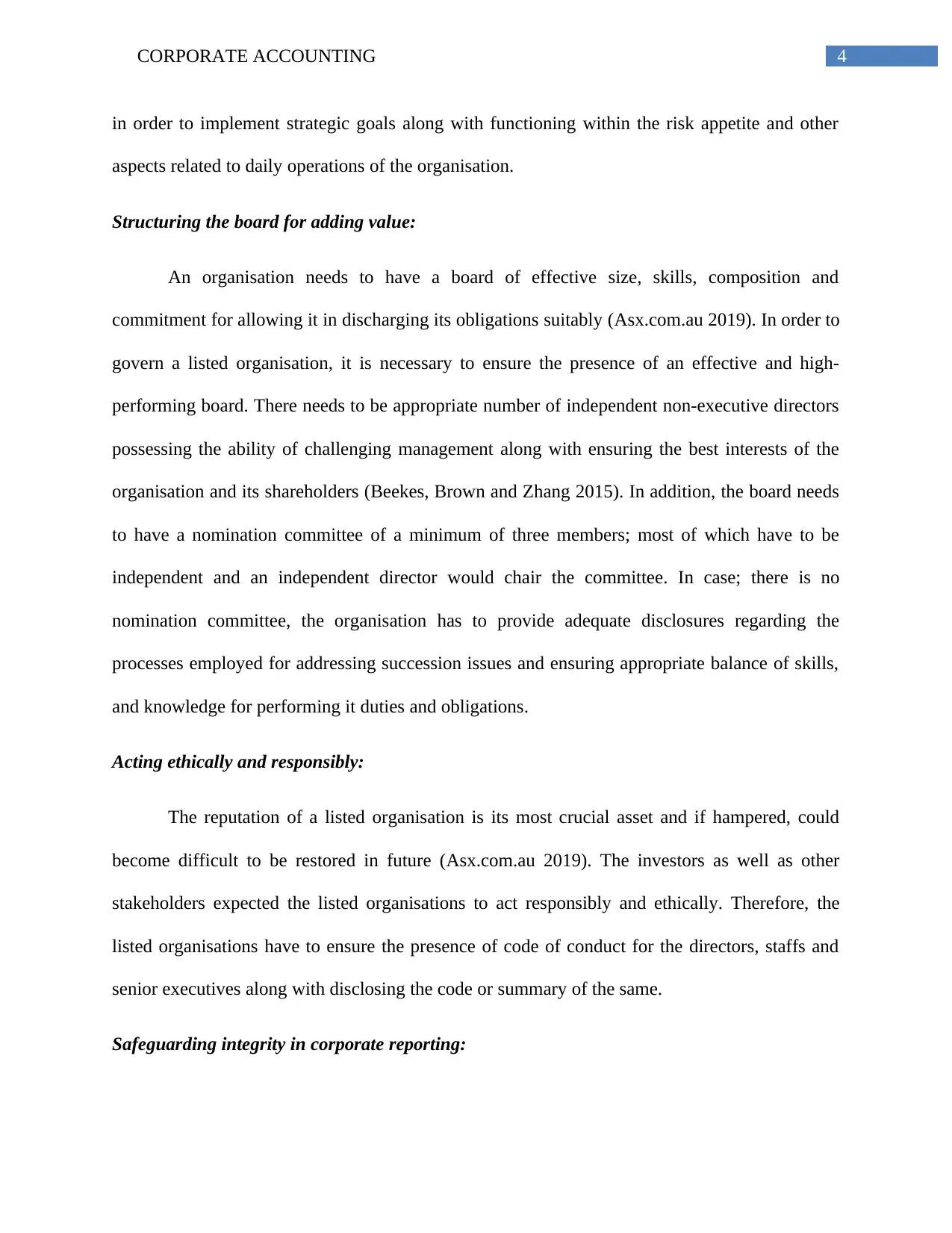
4CORPORATE ACCOUNTING
in order to implement strategic goals along with functioning within the risk appetite and other
aspects related to daily operations of the organisation.
Structuring the board for adding value:
An organisation needs to have a board of effective size, skills, composition and
commitment for allowing it in discharging its obligations suitably (Asx.com.au 2019). In order to
govern a listed organisation, it is necessary to ensure the presence of an effective and high-
performing board. There needs to be appropriate number of independent non-executive directors
possessing the ability of challenging management along with ensuring the best interests of the
organisation and its shareholders (Beekes, Brown and Zhang 2015). In addition, the board needs
to have a nomination committee of a minimum of three members; most of which have to be
independent and an independent director would chair the committee. In case; there is no
nomination committee, the organisation has to provide adequate disclosures regarding the
processes employed for addressing succession issues and ensuring appropriate balance of skills,
and knowledge for performing it duties and obligations.
Acting ethically and responsibly:
The reputation of a listed organisation is its most crucial asset and if hampered, could
become difficult to be restored in future (Asx.com.au 2019). The investors as well as other
stakeholders expected the listed organisations to act responsibly and ethically. Therefore, the
listed organisations have to ensure the presence of code of conduct for the directors, staffs and
senior executives along with disclosing the code or summary of the same.
Safeguarding integrity in corporate reporting:
in order to implement strategic goals along with functioning within the risk appetite and other
aspects related to daily operations of the organisation.
Structuring the board for adding value:
An organisation needs to have a board of effective size, skills, composition and
commitment for allowing it in discharging its obligations suitably (Asx.com.au 2019). In order to
govern a listed organisation, it is necessary to ensure the presence of an effective and high-
performing board. There needs to be appropriate number of independent non-executive directors
possessing the ability of challenging management along with ensuring the best interests of the
organisation and its shareholders (Beekes, Brown and Zhang 2015). In addition, the board needs
to have a nomination committee of a minimum of three members; most of which have to be
independent and an independent director would chair the committee. In case; there is no
nomination committee, the organisation has to provide adequate disclosures regarding the
processes employed for addressing succession issues and ensuring appropriate balance of skills,
and knowledge for performing it duties and obligations.
Acting ethically and responsibly:
The reputation of a listed organisation is its most crucial asset and if hampered, could
become difficult to be restored in future (Asx.com.au 2019). The investors as well as other
stakeholders expected the listed organisations to act responsibly and ethically. Therefore, the
listed organisations have to ensure the presence of code of conduct for the directors, staffs and
senior executives along with disclosing the code or summary of the same.
Safeguarding integrity in corporate reporting:

5CORPORATE ACCOUNTING
The board of a listed organisation needs to have an audit committee comprising of at least
three members and they need to be non-executive directors. An independent director has to chair
the committee and the individual should not be the chairperson of the board. The main role of
this committee would be to assure the adequacy of the corporate reporting processes of the
organisation and the suitability of accounting estimates or choices that the management has
undertaken to prepare the financial statements of the organisation (Chan, Watson and Woodliff
2014).
Undertaking timely and balanced disclosure:
The organisations need to have a written policy for adhering to continuous disclosure
obligations in accordance with the listing rules along with disclosing the policy or summary of
the same (Asx.com.au 2019).
Respecting the rights of the stakeholders:
The organisations have to respect the rights of the shareholders by delivering them with
appropriate information and facilities for enabling them in exercising such rights in an effective
manner (Chapple, Clout and Tan 2014).
Recognising and managing risk:
Any organisation needs to develop effective framework of risk management along with
periodical review of the suitability of such framework.
Fair and responsible remuneration:
The organisations have to pay sufficient director remuneration for attracting and retaining
superior quality directors along with forming its executive remuneration for attracting, retaining
The board of a listed organisation needs to have an audit committee comprising of at least
three members and they need to be non-executive directors. An independent director has to chair
the committee and the individual should not be the chairperson of the board. The main role of
this committee would be to assure the adequacy of the corporate reporting processes of the
organisation and the suitability of accounting estimates or choices that the management has
undertaken to prepare the financial statements of the organisation (Chan, Watson and Woodliff
2014).
Undertaking timely and balanced disclosure:
The organisations need to have a written policy for adhering to continuous disclosure
obligations in accordance with the listing rules along with disclosing the policy or summary of
the same (Asx.com.au 2019).
Respecting the rights of the stakeholders:
The organisations have to respect the rights of the shareholders by delivering them with
appropriate information and facilities for enabling them in exercising such rights in an effective
manner (Chapple, Clout and Tan 2014).
Recognising and managing risk:
Any organisation needs to develop effective framework of risk management along with
periodical review of the suitability of such framework.
Fair and responsible remuneration:
The organisations have to pay sufficient director remuneration for attracting and retaining
superior quality directors along with forming its executive remuneration for attracting, retaining
⊘ This is a preview!⊘
Do you want full access?
Subscribe today to unlock all pages.

Trusted by 1+ million students worldwide
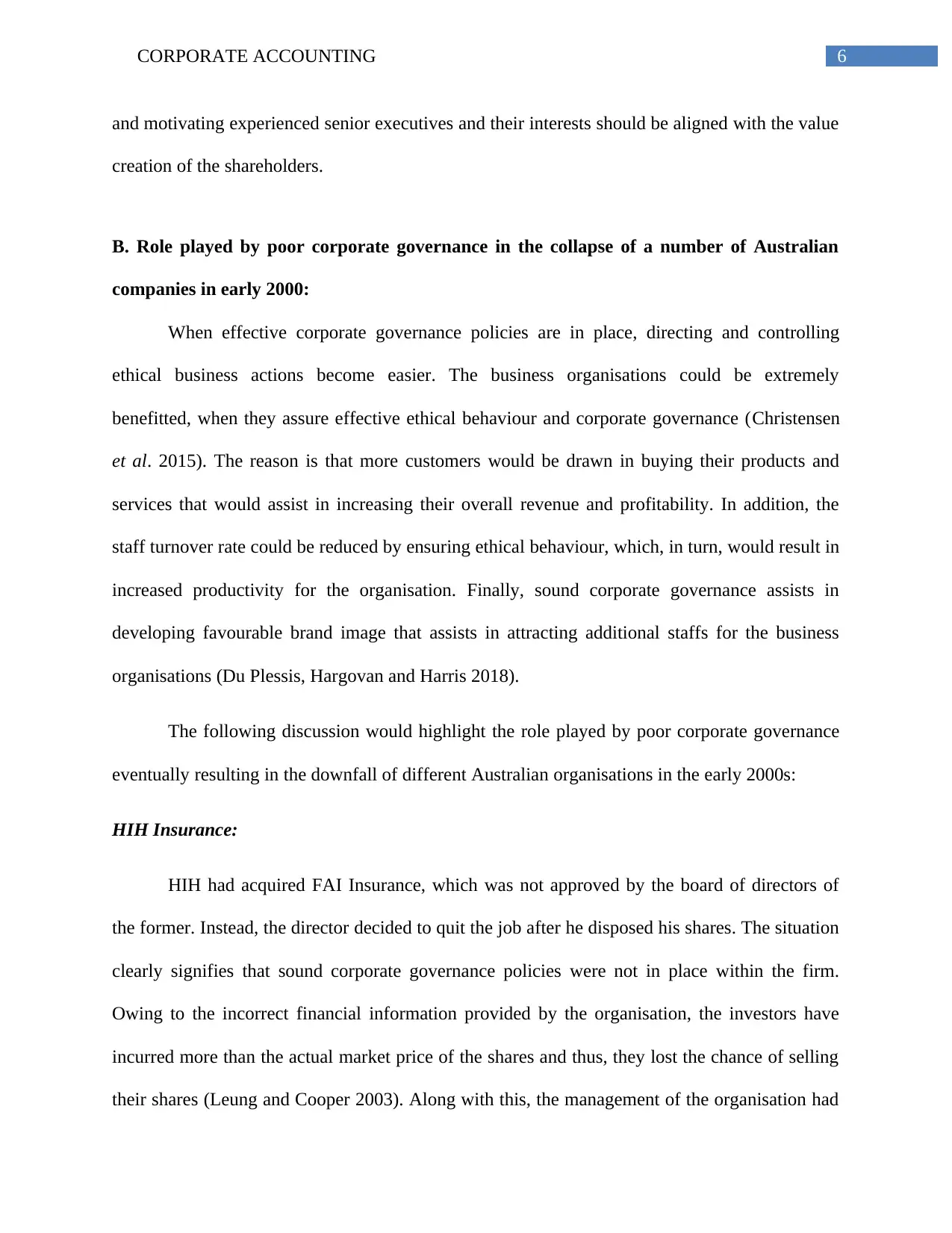
6CORPORATE ACCOUNTING
and motivating experienced senior executives and their interests should be aligned with the value
creation of the shareholders.
B. Role played by poor corporate governance in the collapse of a number of Australian
companies in early 2000:
When effective corporate governance policies are in place, directing and controlling
ethical business actions become easier. The business organisations could be extremely
benefitted, when they assure effective ethical behaviour and corporate governance (Christensen
et al. 2015). The reason is that more customers would be drawn in buying their products and
services that would assist in increasing their overall revenue and profitability. In addition, the
staff turnover rate could be reduced by ensuring ethical behaviour, which, in turn, would result in
increased productivity for the organisation. Finally, sound corporate governance assists in
developing favourable brand image that assists in attracting additional staffs for the business
organisations (Du Plessis, Hargovan and Harris 2018).
The following discussion would highlight the role played by poor corporate governance
eventually resulting in the downfall of different Australian organisations in the early 2000s:
HIH Insurance:
HIH had acquired FAI Insurance, which was not approved by the board of directors of
the former. Instead, the director decided to quit the job after he disposed his shares. The situation
clearly signifies that sound corporate governance policies were not in place within the firm.
Owing to the incorrect financial information provided by the organisation, the investors have
incurred more than the actual market price of the shares and thus, they lost the chance of selling
their shares (Leung and Cooper 2003). Along with this, the management of the organisation had
and motivating experienced senior executives and their interests should be aligned with the value
creation of the shareholders.
B. Role played by poor corporate governance in the collapse of a number of Australian
companies in early 2000:
When effective corporate governance policies are in place, directing and controlling
ethical business actions become easier. The business organisations could be extremely
benefitted, when they assure effective ethical behaviour and corporate governance (Christensen
et al. 2015). The reason is that more customers would be drawn in buying their products and
services that would assist in increasing their overall revenue and profitability. In addition, the
staff turnover rate could be reduced by ensuring ethical behaviour, which, in turn, would result in
increased productivity for the organisation. Finally, sound corporate governance assists in
developing favourable brand image that assists in attracting additional staffs for the business
organisations (Du Plessis, Hargovan and Harris 2018).
The following discussion would highlight the role played by poor corporate governance
eventually resulting in the downfall of different Australian organisations in the early 2000s:
HIH Insurance:
HIH had acquired FAI Insurance, which was not approved by the board of directors of
the former. Instead, the director decided to quit the job after he disposed his shares. The situation
clearly signifies that sound corporate governance policies were not in place within the firm.
Owing to the incorrect financial information provided by the organisation, the investors have
incurred more than the actual market price of the shares and thus, they lost the chance of selling
their shares (Leung and Cooper 2003). Along with this, the management of the organisation had
Paraphrase This Document
Need a fresh take? Get an instant paraphrase of this document with our AI Paraphraser
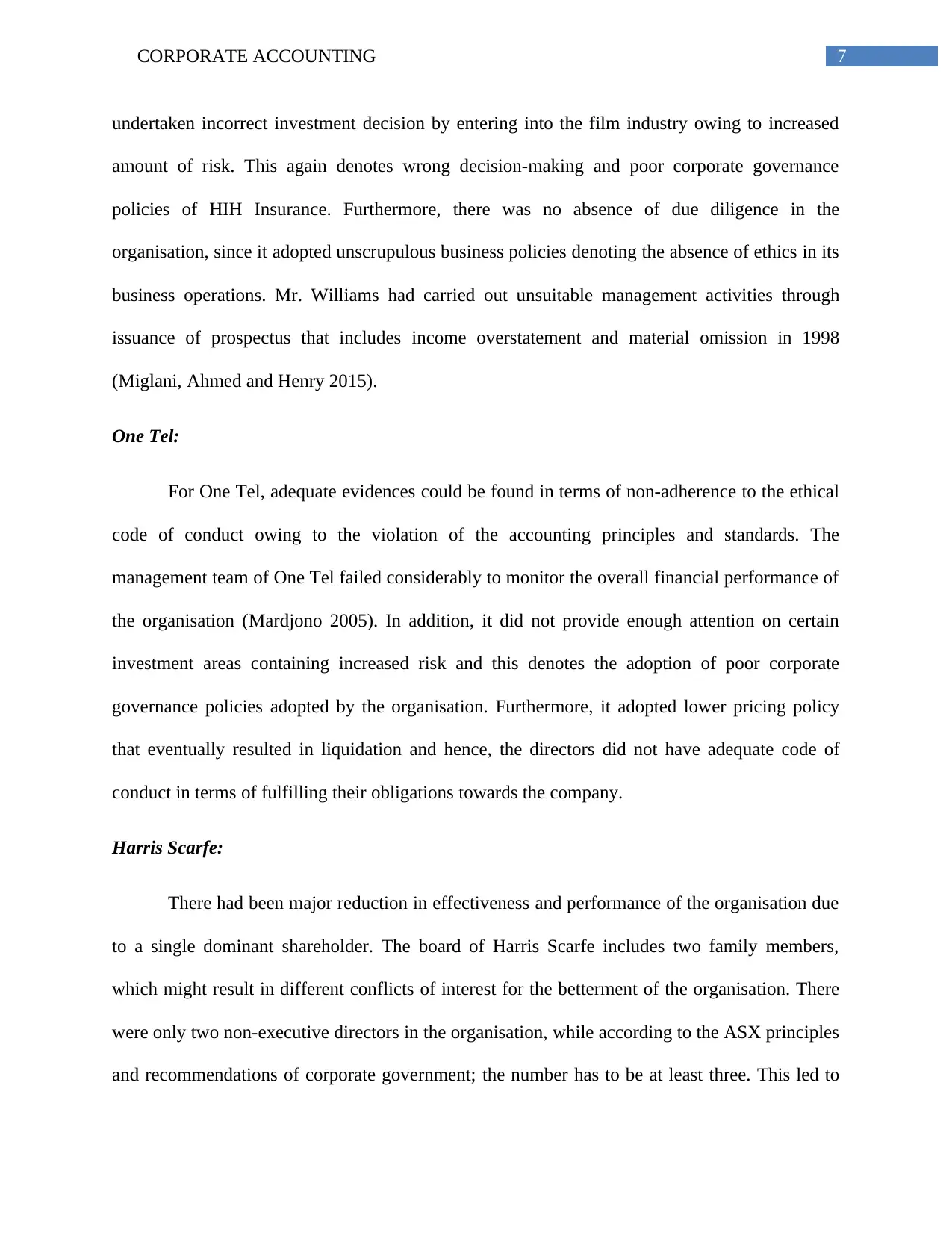
7CORPORATE ACCOUNTING
undertaken incorrect investment decision by entering into the film industry owing to increased
amount of risk. This again denotes wrong decision-making and poor corporate governance
policies of HIH Insurance. Furthermore, there was no absence of due diligence in the
organisation, since it adopted unscrupulous business policies denoting the absence of ethics in its
business operations. Mr. Williams had carried out unsuitable management activities through
issuance of prospectus that includes income overstatement and material omission in 1998
(Miglani, Ahmed and Henry 2015).
One Tel:
For One Tel, adequate evidences could be found in terms of non-adherence to the ethical
code of conduct owing to the violation of the accounting principles and standards. The
management team of One Tel failed considerably to monitor the overall financial performance of
the organisation (Mardjono 2005). In addition, it did not provide enough attention on certain
investment areas containing increased risk and this denotes the adoption of poor corporate
governance policies adopted by the organisation. Furthermore, it adopted lower pricing policy
that eventually resulted in liquidation and hence, the directors did not have adequate code of
conduct in terms of fulfilling their obligations towards the company.
Harris Scarfe:
There had been major reduction in effectiveness and performance of the organisation due
to a single dominant shareholder. The board of Harris Scarfe includes two family members,
which might result in different conflicts of interest for the betterment of the organisation. There
were only two non-executive directors in the organisation, while according to the ASX principles
and recommendations of corporate government; the number has to be at least three. This led to
undertaken incorrect investment decision by entering into the film industry owing to increased
amount of risk. This again denotes wrong decision-making and poor corporate governance
policies of HIH Insurance. Furthermore, there was no absence of due diligence in the
organisation, since it adopted unscrupulous business policies denoting the absence of ethics in its
business operations. Mr. Williams had carried out unsuitable management activities through
issuance of prospectus that includes income overstatement and material omission in 1998
(Miglani, Ahmed and Henry 2015).
One Tel:
For One Tel, adequate evidences could be found in terms of non-adherence to the ethical
code of conduct owing to the violation of the accounting principles and standards. The
management team of One Tel failed considerably to monitor the overall financial performance of
the organisation (Mardjono 2005). In addition, it did not provide enough attention on certain
investment areas containing increased risk and this denotes the adoption of poor corporate
governance policies adopted by the organisation. Furthermore, it adopted lower pricing policy
that eventually resulted in liquidation and hence, the directors did not have adequate code of
conduct in terms of fulfilling their obligations towards the company.
Harris Scarfe:
There had been major reduction in effectiveness and performance of the organisation due
to a single dominant shareholder. The board of Harris Scarfe includes two family members,
which might result in different conflicts of interest for the betterment of the organisation. There
were only two non-executive directors in the organisation, while according to the ASX principles
and recommendations of corporate government; the number has to be at least three. This led to

8CORPORATE ACCOUNTING
the minimisation of the amount of attention provided by the non-executive directors to Harris
Scarfe (Leung and Cooper 2003). The independent directors entitled to undertake significant and
tough decisions for the organisation had been only 24%, which were supposed to 45% in
accordance with ASX. In terms of committee composition on Harris Scarfe, there had been two
members of the former audit partner and there was no independent director in the audit
committee (Qu et al. 2018). Moreover, there was no female member in the board, which should
be at least 10% according to ASX, which has been one of the reasons of failure.
C. Corporate governance reforms introduced by the Australian government in response to
the corporate collapses of the early 2000s:
In response to the corporate collapses of the early 2000s, Australia has introduced
significant corporate governance reforms. One such reform is “Corporate Law Economic Reform
Program Act (CLERP 9) 2004” initiated on 1st July 2004 for providing response to the public
outcry immediately following the corporate scandals (Carnegie and O’Connell 2014). According
to this reform, the organisations have to make additional disclosures in relation to remuneration
of directors, requirements formulated for enhancing their accountability of firm officers in terms
of wrong financial reporting, stringent requirements for corporate disclosure, measures
undertaken for increasing auditor independence and higher penalties for non-adherence.
For instance, there has been introduction of increased disclosures for executive and
director remuneration accompanied by an obligation of featuring a remuneration report as a
separate section in the annual report of an organisation (Sivathaasan 2016). In addition, the
shareholders of the listed organisation have been provided with the opportunity of addressing the
remuneration of top-level executives. In terms of financial reporting, the CFO and CEO of an
the minimisation of the amount of attention provided by the non-executive directors to Harris
Scarfe (Leung and Cooper 2003). The independent directors entitled to undertake significant and
tough decisions for the organisation had been only 24%, which were supposed to 45% in
accordance with ASX. In terms of committee composition on Harris Scarfe, there had been two
members of the former audit partner and there was no independent director in the audit
committee (Qu et al. 2018). Moreover, there was no female member in the board, which should
be at least 10% according to ASX, which has been one of the reasons of failure.
C. Corporate governance reforms introduced by the Australian government in response to
the corporate collapses of the early 2000s:
In response to the corporate collapses of the early 2000s, Australia has introduced
significant corporate governance reforms. One such reform is “Corporate Law Economic Reform
Program Act (CLERP 9) 2004” initiated on 1st July 2004 for providing response to the public
outcry immediately following the corporate scandals (Carnegie and O’Connell 2014). According
to this reform, the organisations have to make additional disclosures in relation to remuneration
of directors, requirements formulated for enhancing their accountability of firm officers in terms
of wrong financial reporting, stringent requirements for corporate disclosure, measures
undertaken for increasing auditor independence and higher penalties for non-adherence.
For instance, there has been introduction of increased disclosures for executive and
director remuneration accompanied by an obligation of featuring a remuneration report as a
separate section in the annual report of an organisation (Sivathaasan 2016). In addition, the
shareholders of the listed organisation have been provided with the opportunity of addressing the
remuneration of top-level executives. In terms of financial reporting, the CFO and CEO of an
⊘ This is a preview!⊘
Do you want full access?
Subscribe today to unlock all pages.

Trusted by 1+ million students worldwide
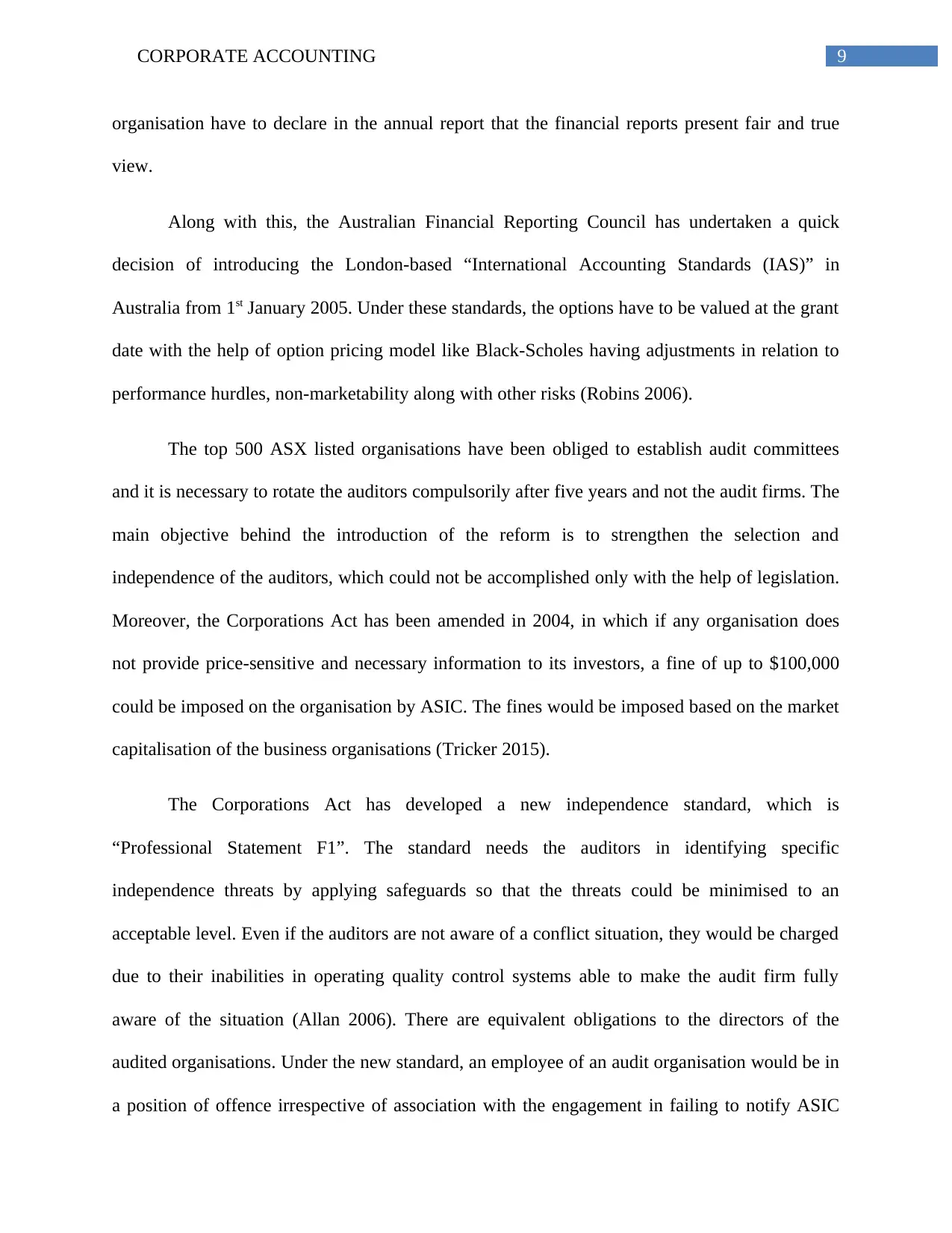
9CORPORATE ACCOUNTING
organisation have to declare in the annual report that the financial reports present fair and true
view.
Along with this, the Australian Financial Reporting Council has undertaken a quick
decision of introducing the London-based “International Accounting Standards (IAS)” in
Australia from 1st January 2005. Under these standards, the options have to be valued at the grant
date with the help of option pricing model like Black-Scholes having adjustments in relation to
performance hurdles, non-marketability along with other risks (Robins 2006).
The top 500 ASX listed organisations have been obliged to establish audit committees
and it is necessary to rotate the auditors compulsorily after five years and not the audit firms. The
main objective behind the introduction of the reform is to strengthen the selection and
independence of the auditors, which could not be accomplished only with the help of legislation.
Moreover, the Corporations Act has been amended in 2004, in which if any organisation does
not provide price-sensitive and necessary information to its investors, a fine of up to $100,000
could be imposed on the organisation by ASIC. The fines would be imposed based on the market
capitalisation of the business organisations (Tricker 2015).
The Corporations Act has developed a new independence standard, which is
“Professional Statement F1”. The standard needs the auditors in identifying specific
independence threats by applying safeguards so that the threats could be minimised to an
acceptable level. Even if the auditors are not aware of a conflict situation, they would be charged
due to their inabilities in operating quality control systems able to make the audit firm fully
aware of the situation (Allan 2006). There are equivalent obligations to the directors of the
audited organisations. Under the new standard, an employee of an audit organisation would be in
a position of offence irrespective of association with the engagement in failing to notify ASIC
organisation have to declare in the annual report that the financial reports present fair and true
view.
Along with this, the Australian Financial Reporting Council has undertaken a quick
decision of introducing the London-based “International Accounting Standards (IAS)” in
Australia from 1st January 2005. Under these standards, the options have to be valued at the grant
date with the help of option pricing model like Black-Scholes having adjustments in relation to
performance hurdles, non-marketability along with other risks (Robins 2006).
The top 500 ASX listed organisations have been obliged to establish audit committees
and it is necessary to rotate the auditors compulsorily after five years and not the audit firms. The
main objective behind the introduction of the reform is to strengthen the selection and
independence of the auditors, which could not be accomplished only with the help of legislation.
Moreover, the Corporations Act has been amended in 2004, in which if any organisation does
not provide price-sensitive and necessary information to its investors, a fine of up to $100,000
could be imposed on the organisation by ASIC. The fines would be imposed based on the market
capitalisation of the business organisations (Tricker 2015).
The Corporations Act has developed a new independence standard, which is
“Professional Statement F1”. The standard needs the auditors in identifying specific
independence threats by applying safeguards so that the threats could be minimised to an
acceptable level. Even if the auditors are not aware of a conflict situation, they would be charged
due to their inabilities in operating quality control systems able to make the audit firm fully
aware of the situation (Allan 2006). There are equivalent obligations to the directors of the
audited organisations. Under the new standard, an employee of an audit organisation would be in
a position of offence irrespective of association with the engagement in failing to notify ASIC
Paraphrase This Document
Need a fresh take? Get an instant paraphrase of this document with our AI Paraphraser
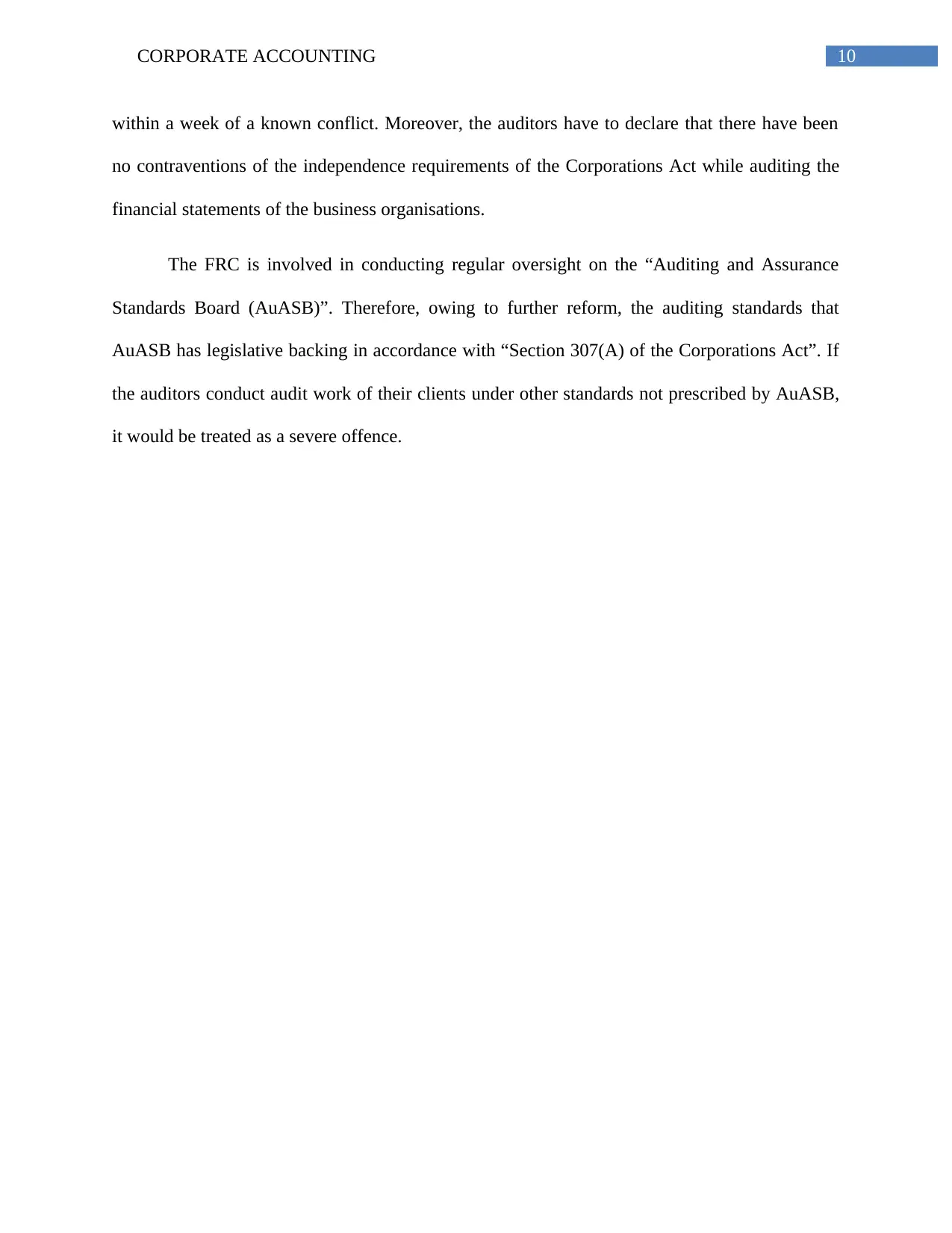
10CORPORATE ACCOUNTING
within a week of a known conflict. Moreover, the auditors have to declare that there have been
no contraventions of the independence requirements of the Corporations Act while auditing the
financial statements of the business organisations.
The FRC is involved in conducting regular oversight on the “Auditing and Assurance
Standards Board (AuASB)”. Therefore, owing to further reform, the auditing standards that
AuASB has legislative backing in accordance with “Section 307(A) of the Corporations Act”. If
the auditors conduct audit work of their clients under other standards not prescribed by AuASB,
it would be treated as a severe offence.
within a week of a known conflict. Moreover, the auditors have to declare that there have been
no contraventions of the independence requirements of the Corporations Act while auditing the
financial statements of the business organisations.
The FRC is involved in conducting regular oversight on the “Auditing and Assurance
Standards Board (AuASB)”. Therefore, owing to further reform, the auditing standards that
AuASB has legislative backing in accordance with “Section 307(A) of the Corporations Act”. If
the auditors conduct audit work of their clients under other standards not prescribed by AuASB,
it would be treated as a severe offence.
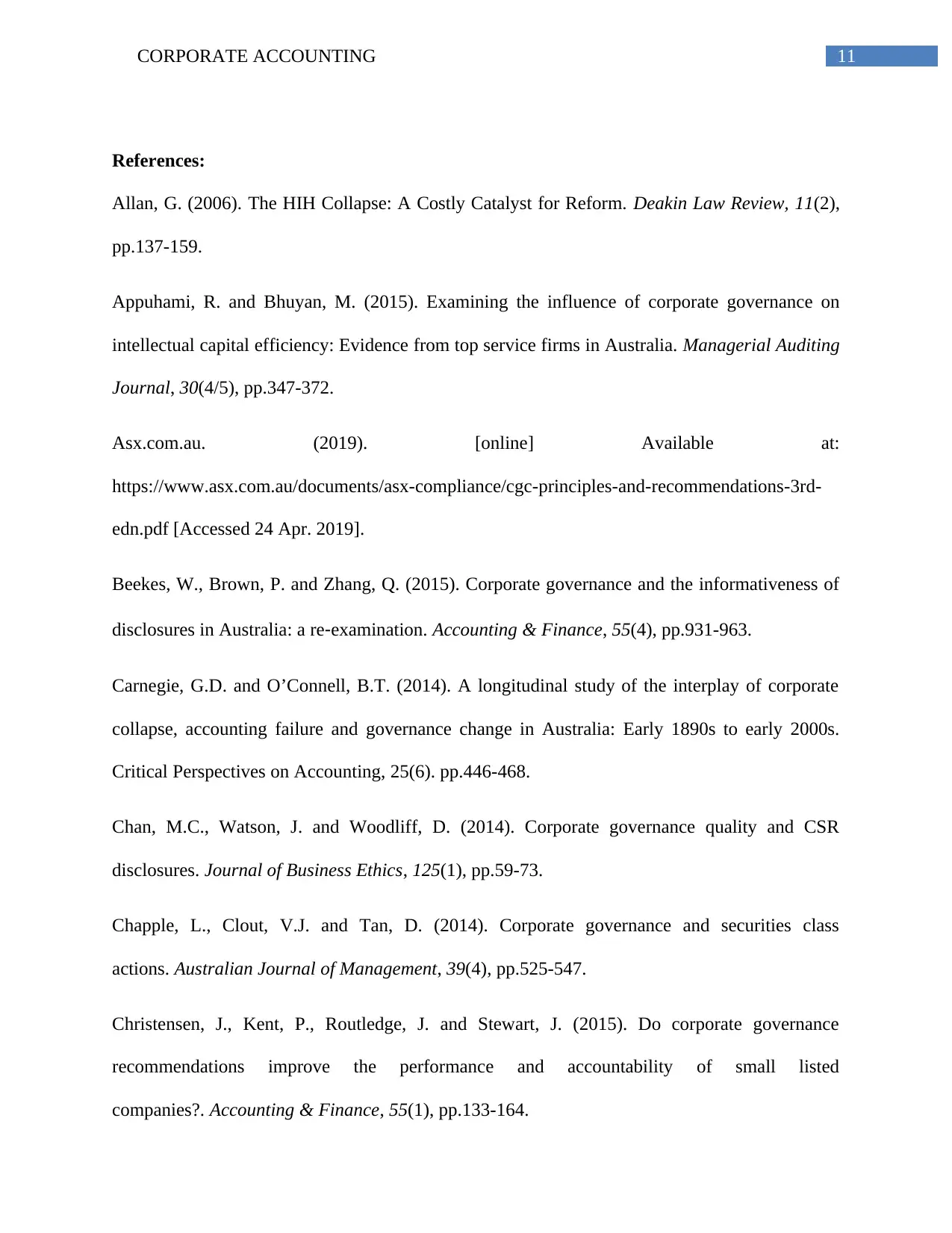
11CORPORATE ACCOUNTING
References:
Allan, G. (2006). The HIH Collapse: A Costly Catalyst for Reform. Deakin Law Review, 11(2),
pp.137-159.
Appuhami, R. and Bhuyan, M. (2015). Examining the influence of corporate governance on
intellectual capital efficiency: Evidence from top service firms in Australia. Managerial Auditing
Journal, 30(4/5), pp.347-372.
Asx.com.au. (2019). [online] Available at:
https://www.asx.com.au/documents/asx-compliance/cgc-principles-and-recommendations-3rd-
edn.pdf [Accessed 24 Apr. 2019].
Beekes, W., Brown, P. and Zhang, Q. (2015). Corporate governance and the informativeness of
disclosures in Australia: a re‐examination. Accounting & Finance, 55(4), pp.931-963.
Carnegie, G.D. and O’Connell, B.T. (2014). A longitudinal study of the interplay of corporate
collapse, accounting failure and governance change in Australia: Early 1890s to early 2000s.
Critical Perspectives on Accounting, 25(6). pp.446-468.
Chan, M.C., Watson, J. and Woodliff, D. (2014). Corporate governance quality and CSR
disclosures. Journal of Business Ethics, 125(1), pp.59-73.
Chapple, L., Clout, V.J. and Tan, D. (2014). Corporate governance and securities class
actions. Australian Journal of Management, 39(4), pp.525-547.
Christensen, J., Kent, P., Routledge, J. and Stewart, J. (2015). Do corporate governance
recommendations improve the performance and accountability of small listed
companies?. Accounting & Finance, 55(1), pp.133-164.
References:
Allan, G. (2006). The HIH Collapse: A Costly Catalyst for Reform. Deakin Law Review, 11(2),
pp.137-159.
Appuhami, R. and Bhuyan, M. (2015). Examining the influence of corporate governance on
intellectual capital efficiency: Evidence from top service firms in Australia. Managerial Auditing
Journal, 30(4/5), pp.347-372.
Asx.com.au. (2019). [online] Available at:
https://www.asx.com.au/documents/asx-compliance/cgc-principles-and-recommendations-3rd-
edn.pdf [Accessed 24 Apr. 2019].
Beekes, W., Brown, P. and Zhang, Q. (2015). Corporate governance and the informativeness of
disclosures in Australia: a re‐examination. Accounting & Finance, 55(4), pp.931-963.
Carnegie, G.D. and O’Connell, B.T. (2014). A longitudinal study of the interplay of corporate
collapse, accounting failure and governance change in Australia: Early 1890s to early 2000s.
Critical Perspectives on Accounting, 25(6). pp.446-468.
Chan, M.C., Watson, J. and Woodliff, D. (2014). Corporate governance quality and CSR
disclosures. Journal of Business Ethics, 125(1), pp.59-73.
Chapple, L., Clout, V.J. and Tan, D. (2014). Corporate governance and securities class
actions. Australian Journal of Management, 39(4), pp.525-547.
Christensen, J., Kent, P., Routledge, J. and Stewart, J. (2015). Do corporate governance
recommendations improve the performance and accountability of small listed
companies?. Accounting & Finance, 55(1), pp.133-164.
⊘ This is a preview!⊘
Do you want full access?
Subscribe today to unlock all pages.

Trusted by 1+ million students worldwide
1 out of 13
Related Documents
Your All-in-One AI-Powered Toolkit for Academic Success.
+13062052269
info@desklib.com
Available 24*7 on WhatsApp / Email
![[object Object]](/_next/static/media/star-bottom.7253800d.svg)
Unlock your academic potential
Copyright © 2020–2025 A2Z Services. All Rights Reserved. Developed and managed by ZUCOL.





